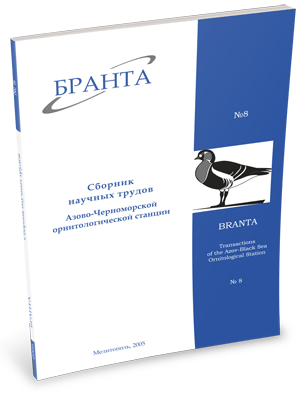
Transactions
of the Azov-Black Sea Ornithological Station



Post-breeding distribution and migrations of Pelecaniformes and Ciconiiformes in the north-western Crimea
S.Yu. Kostin, N.A. Tarina
This publication presents the material on distribution and numbers of representatives of Pelicaniformes and Ciconiiformes in the north-western part of the Crimea out of the breeding period (summering, post-breeding movements, passage, wintering), phenology and migratory routes of local birds. The paper continues the work started earlier (Kostin, Tarina, 2004) - compiling the review on current state of populations of these taxa in the region.
The reviewed territory covers a part of Kalamitskiy Bay to the spit of Lake Sakskoye in the south, the Crimean coast of Karkinitskiy Bay in the north to the valley of Vorontsovka River in the north-east, and the elevated-plain steppe of Tarkhankut in the west. The publication is based on the material obtained by authors in 1983-2004. Archives and literary sources were used as well.
Results and discussion
During the post-breeding movements (early June to late September) the numbers of Ciconiiformes increase about three times in comparison with the start of the breeding period and equal to 6,000-7,000 birds. During the autumn migration the numbers of Ciconiiformes decrease because of local birds leaving, while passage birds do not contribute to considerable growth of numbers. In winter there are near 500-700 individuals of Ciconiiformes in the region, mainly they are Great White Egret and Grey Heron, and about 100-160 individuals of Cormorant. Single individuals of other representatives of Pelicaniformes and Ciconiiformes (Pygmy Cormorant, Bittern) are rarely observed in winter. The total numbers of Ciconiiformes during their spring passage can be estimated as 3500-4000 birds, of them 2500-3000 are local birds gathering at the breeding areas. The most numerous summer movements of non-breeding birds are registered for Pelicaniformes (Cormorant, White Pelican) with total numbers up to 2,500-3,000 birds, while the numbers of summering Ciconiiformes are 1,000-1,500 individuals.
The overall duration of spring migration is 105-110 days - from the second decade of February to early June with its peak in April. That of the autumn migration is 130-140 days from the second half of July to the first decade of December with peaks in September-October. A wintering complex finishes its formation in the second decade of December and dissimilates till the middle of February.
Main wintering areas of Cormorant are the east near Azov area, Black Sea and Mediterranean basins. For mentioned there representatives of Ciconiiformes they are the south of the Black Sea area, Mediterranean area, Central Africa and Western Africa.
Conclusion
In the north-western part of the Crimea there are 5 representatives of Pelicaniformes and 13 species of Ciconiiformes. They are of such families as Ardeidae (9 species), Threskiornithidae (2 species), and Ciconiidae (2 species).
Over the last forty years distribution, numbers and characteristics of staying for the most representatives of these orders have deeply changed. Another 3 species of Ardeidae (Bittern, Great White Egret and Grey Heron) and 2 species of cormorants (Cormorant and Pygmy Cormorant) also start wintering there.
White Pelican and Spoonbill were rare passage birds, but now they are breeding, usually passaging and summering species. For the last 15-20 years the start of the spring passage of Grey Heron, Great White Egret and Purple Heron shifted to earlier dates, and thus duration of the migration increased averagely for 1.5 months. Also there are evidences of a settled life of a part of populations of Great White Egret and Grey Heron.
The way that Glossy Ibis, Grey Heron and Little Egret use to get to their wintering grounds in Africa is still unclear. The wintering areas of "Lebyazhy" breeding groups of Bittern and Little Bittern, Squacco Heron and Purple Heron, and Spoonbill are not identified.
Read the paper in a PDF file